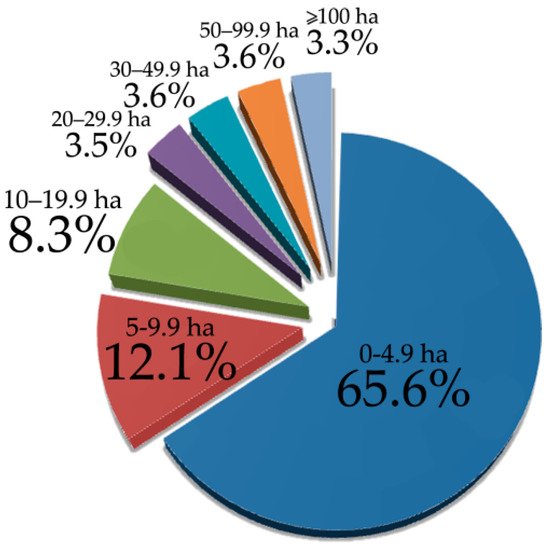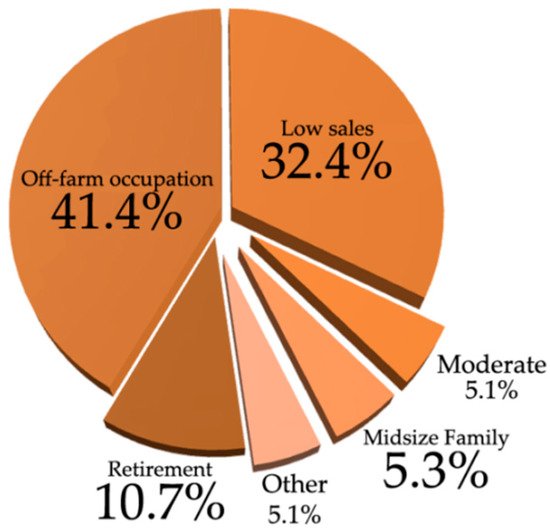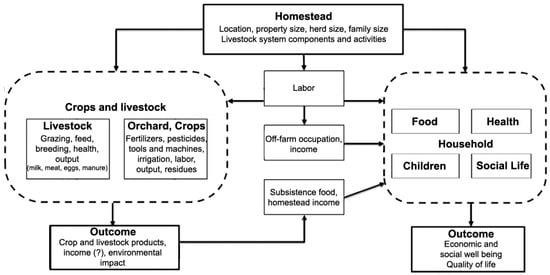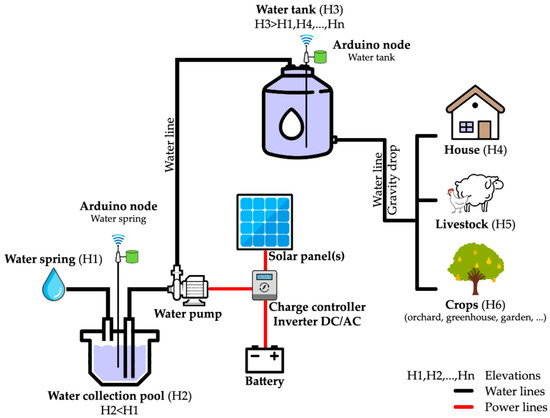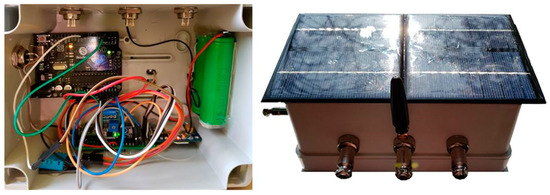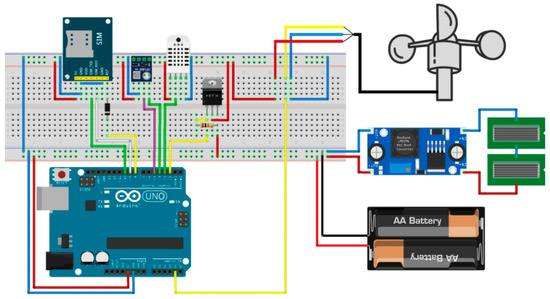1. Small Farm andor Homesteading Basics
There is no universally accepted definition of a small farm or a homestead. Although the farm size is usually estimated by the arable land size, other criteria should also be taken into account, such as economic size, herd size, labor force and market share. In general, small farms are defined as those with an arable area sized under 5 hectares (ha)
[1]. According to the newest publicly available data, in the European Union (EU), there was a total of 10.5 million farms in 2016, most of them being small (<5 ha, 65.6%/~6.9 million),
Figure 1 [2]. The farm size in the US is measured by annual Gross Cash Farm Income (GCFI) rather than land size. Having over 2 million farms in 2019
[3], small family farms were the most numerous (89.60%, GCFI < $350,000),
Figure 2 [4]. Small farms have been identified as very important in the provision of additional income and food for their owners, thus reducing the risk of rural poverty
[2].
Figure 1.
Farm size distribution in the EU (2016).
Figure 2.
Farm size distribution in the US (2019).
A homestead requires a steady supply of water and electricity, and often the easiest method to overcome this problem is to connect the property to the city water supply, sewerage and power grid. However, this is often not an option due to the property’s location or the owner’s intention to keep the homestead off-grid and self-sufficient.
The main segments to pay attention to when establishing a homestead are:
- Water and electricity management;
- Crops and livestock management;
- Homestead security.
Figure 3 demonstrates a generic farming diagram adapted to a homesteading scenario, with system components and interactions which should be addressed when modeling technical solutions
[5]. The list can vary depending on the property configuration, available means, family composition, etc.
Figure 3. Farming diagram—structure of the system components and interactions.
Farming diagram—structure of the system components and interactions, based on [5].
2. Water Management
The core prerequisite for the homestead to be suitable for sustainable living is to provide a sufficient amount of drinking and technical water that can be used for drinking, cooking, personal hygiene, watering animals and irrigation of plants. If the city water line is not available, the required amounts of water can be provided by collection from natural springs or water streams on the property, wells, rainwater harvesting or fog harvesting. The collected water can be stored in a purpose-built water harvesting pond or in tanks, and piped to specific spots on the property.
Depending on the terrain configuration, the most energy efficient solution of water distribution is by gravity drop. Otherwise, the use of electric pumps will be required, including additional solar panels and batteries for electric power generation and storage,
Figure 4 [6].
Figure 4. Autonomous wireless water management system in mountainous homestead.
Autonomous wireless water management system in mountainous homestead [6].
The water system can be divided into smaller, independent subsystems with automated water distribution, depending on the disposition of water collection spots and tanks. Grey water can be filtered and reused for irrigation and toilet flushing, while black water must be properly stored in order to prevent pollution.
3. Electricity Management
If the property is not connected to the power grid, it is necessary to produce and store the electricity locally. This can be achieved by using hydropower if an adequate water stream is available, wind or solar energy. The excess of electricity produced needs to be stored for later use, most commonly in Li-ion battery banks with enough capacity to power a household for approximately 3 days
[7], to overcome periods with no wind, or during winter when solar panels cannot produce a nominal amount of electricity. Despite efforts to generate electricity from renewable sources, having one or more gas- or diesel-powered electric generators on the homestead is a must.
Similar to the water system, the electric system on the property does not have to be designed as a whole, but rather can consist of multiple individual segments intended to power separate objects.
4. Crops Management
Providing a sufficient amount of water to the plants on the property is a task that requires time and manual work. Therefore, plant irrigation systems are considered as one of the most important components of the homestead, especially in locations with low, or abundant but seasonal rainfall. Irrigation systems make the cultivation of plants in harsh locations possible. However, if the soil gets overwatered, salt levels may rise and become harmful to plants.
The most popular irrigation systems are the drip system and sprinklers. The water flow is controlled by valves operated manually, or by a microcontroller via electrically actuated valves in preprogrammed time intervals. The fact that the watering times are manually set is one of the main disadvantages of such systems, implicating a reprogramming of the microcontroller each time a change of irrigation regime is required. Noncompliance with the current weather conditions may lead to insufficient or excessive watering of plants.
Crops are mostly affected by plant diseases and pests, which can go unnoticed until the problem cannot be controlled. Even when changes on the plant are noticed, they can be misinterpreted as just a stage in the development of the plant, which may allow the disease to spread to other plants and consequently reduce the yield on the homestead.
The phenology of agricultural plants studies the life cycle of the plants and how they are affected by seasonal changes in the environment
[8]. Tiny variations in temperature and humidity can seriously affect plant yields, so historical phenological logs can be useful when making decisions on growing crops. Historical temperature values are valuable source that can be used to study climate change as well.
IoT-based meteorological stations can be used to monitor the microclimatic conditions on the property, i.e., the current weather parameters, and the detection of possible extreme values that may present a risk to crop production, such as high or low temperatures, hailstorms, cyclones, floods and the like. It can help predict the size and level of threat from pest populations as well. The layout of electronic components of an Arduino-based automatic meteorological station (AMS) is given in
Figure 5 and
Figure 6 [9].
Figure 5.
AMS: Arduino microcontroller with electronic components (
left
) and layout of ports and solar panels (
right).
). Reproduced with permission from [9], Singidunum University.
Figure 6. Arduino AMS, breadboard scheme.
Arduino AMS based on the project described in [9], breadboard scheme.
Estimation of yield, especially in fruit production, can be a difficult task due to the uneven development and ripening of fruits on different plants. If done manually, it requires daily visits and assessments. In order to make the work easier and somewhat faster, homesteaders may take a series of photographs used to assess the number of fruits suitable for collection, but the process is time consuming, unreliable and subject to human factor.
A specific type of plants growing is a greenhouse production, suitable in areas with unstable climatic conditions in order to maintain optimal conditions for plant growth
[10]. The controlled environment in the greenhouse enables higher yields of better quality and an increased number of harvests compared to conventional production, as well as a lesser use of pesticides. The price of greenhouse production is mostly influenced by the energy needed for heating or cooling, which can be partially regulated by the use of optimal building materials, as well as the use of renewable energy sources.
5. Livestock Management
If animals are kept on the homestead, appropriate nutrition and care must be provided, and if possible, regularly logged for later reference. In case of larger animals, it is always a good practice to log information on each individual animal, such as milk production, behavior, fertility, health, etc. In case of illness, the animal needs to be isolated from the herd so that the disease does not spread.
6. Homestead Security
In general, a homestead may have assets and equipment with a significant financial value and thus can be a potential target of theft. Properties with owners who practice a hybrid lifestyle, spending a part of their time in the city, can be especially vulnerable.
Equipment that is particularly interesting for theft includes solar panels, batteries, pumps, vehicles, machinery and tools, but wood, crops and animals can be targeted as well. Therefore, when forming a homestead, it is a good strategy to dedicate a part of the funds for the property protection, which can be physical, electric, electronic and financial.
7. Industrial Agriculture vs. Small-Scale Farming
Finally, the rising question is whether individual agricultural production can survive economically in a market dominated by industrial mass production, and what are the competitive advantages that make it attractive.
The industrial production of crops, animals and animal products implies the rapid adoption and implementation of innovations in agricultural methods and machinery, including aggressive methods of protecting crops and animals from disease, genetic modification, mass production techniques, creation of new markets, application of patent protection to genetic information and global trade
[11][12][13]. Most of the economically affordable meat, dairy products, eggs, fruits and vegetables available in supermarkets are products of the industrial agriculture. For industrial farms, the economy of production is a basic priority, i.e., producing as many products as possible in the shortest possible time, at a competitive price that will maximize profit. To achieve this, chemicals are used in production, which significantly affect the quality of products and the acceptance of such products on the market. Industrial agricultural products do not have the same taste or nutritional value as naturally grown crops. Industrial farms also consume more energy and water than local farms, which in the long run leads to environmental problems
[13].
In contrast to industrial production, a local agriculture strives to be environmentally friendly, with a balanced consumption of resources that can be renewed in a reasonable period of time, while maintaining soil fertility by using organic fertilizers without chemicals and maintaining economic efficiency
[14]. Organic products from small farms are more expensive in retail, but the quality of these products justifies the additional cost.
8. Autonomous Machinery and Robots
Autonomous agricultural machines (AAMs) can significantly facilitate work on farms. In order for such a machine to be successful, it must be able to follow the previously set tasks, to be able to act in unforeseen situations such as obstacles, and to be able to act reflexively, i.e., instantaneously make decisions without lengthy calculations
[15]. Since it is difficult to automate high-level reasoning and tasks with the available technology, it would be beneficial that the humans remain in the decision-making loop to assist with the planning of field operations, resources allocation, coordination of autonomous machines and increase the overall reliability and performance of the system
[16].
However, although the development of AAMs has been talked about for a long time and prototypes are often presented in the media, only a few models are currently available on the market. At the moment, large machines for industrial agriculture seem to dominate the market, but they are out of reach for individual farms, being oversized and expensive.
Another obstacle to the wider application of autonomous agricultural machines is legal regulation, which must address the requirements for on-site human supervision, liability for autonomous machine errors and intellectual property in robotic learning
[17].
It is estimated that until 2025, farmers will not use fully autonomous machines commercially, while the class of supervised autonomous machines will only represent a market niche in the high-tech regions of North America and Western Europe. Apart from the African and Asian markets, human-assisted tractors and combines will have the largest market share.
